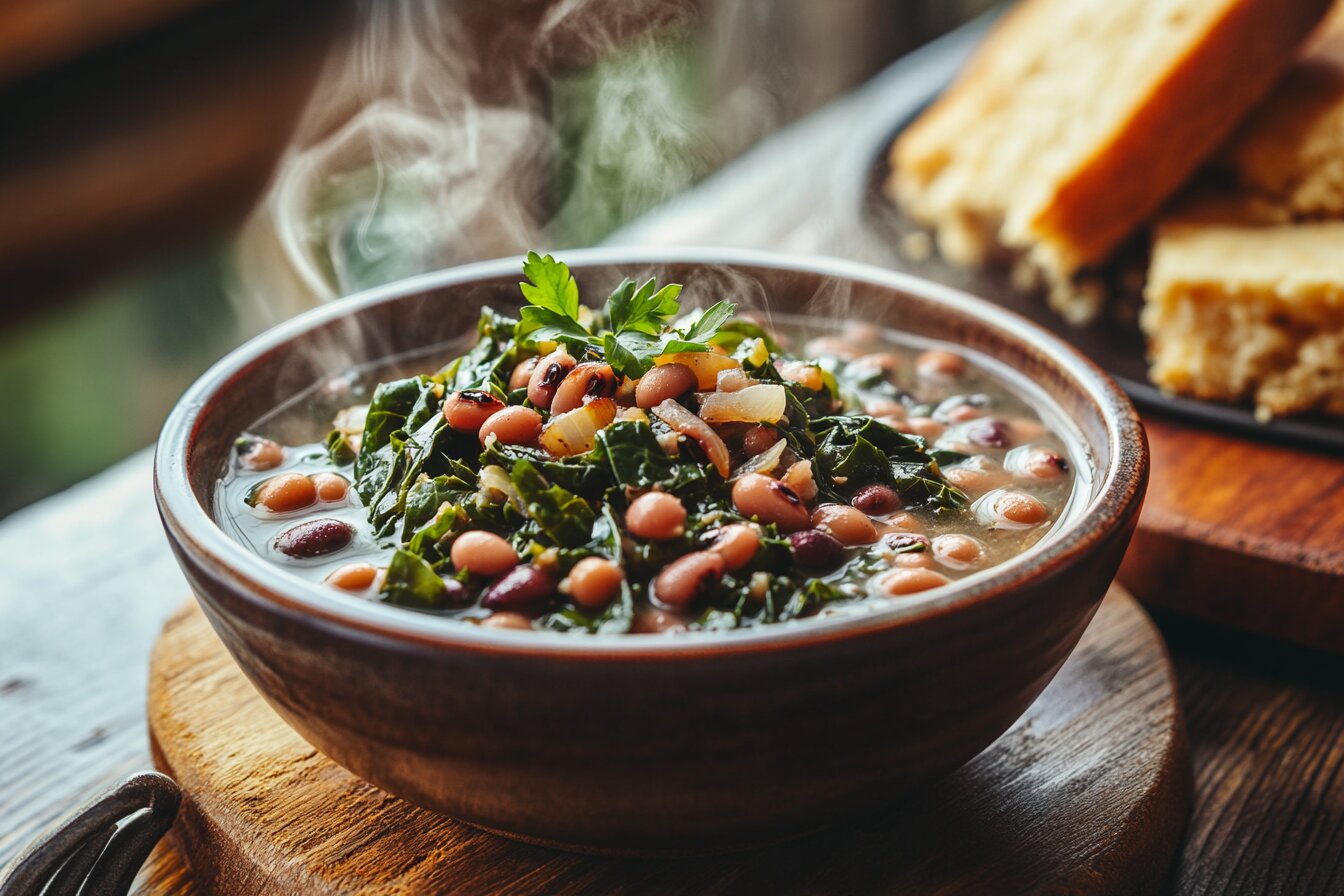In the heart of Southern cuisine, black eyed peas and collard greens are a classic. This iconic mix is a staple in the region. It offers a comforting and nutritious meal that celebrates the American South’s rich culinary heritage.
The dish’s significance goes beyond its tasty flavors. It is deeply rooted in the traditions and cultural identity of the region.
Blending earthy, nutrient-dense greens with creamy, protein-packed black eyed peas, this recipe captures the soulful essence of Southern fare. Whether enjoyed as a hearty main course or part of a larger spread, it warms the heart and satisfies the palate.
Key Takeaways
- Black eyed peas and collard greens are a quintessential dish in Southern American cuisine.
- The dish holds cultural significance, often associated with New Year’s Day celebrations and traditions.
- This recipe combines the nutritional benefits of black eyed peas and collard greens for a wholesome and comforting meal.
- Preparing the dish with traditional seasonings and cooking methods results in a flavorful and authentic Southern dish.
- Serving the black eyed peas and collard greens with complementary side dishes, such as cornbread, enhances the overall dining experience.
The Rich History Behind Black-Eyed Peas and Collard Greens Dishes
Black eyed peas and collard greens are beloved in Southern cuisine. They have a deep history in African American cuisine. These simple ingredients have greatly influenced Southern food history and African American cuisine for centuries.
Southern Cuisine Origins of Black-Eyed Peas and Collard Greens
Black eyed peas were brought to the US by enslaved Africans. They quickly became a staple in Southern cooking. Collard greens also have African roots and became popular in the South.
Cultural Significance of Black-Eyed Peas and Collard Greens Traditions
For the African American community, these dishes hold deep cultural significance. They are symbols of good luck and prosperity, especially when eaten on New Year’s Day — a tradition that brings hope for the year ahead.
New Year’s Day Connection
Eating these traditional dishes on New Year’s Day is a long-standing custom believed to bring good fortune. The peas symbolize coins, while the greens represent dollar bills. This practice continues to be celebrated in the South and beyond.
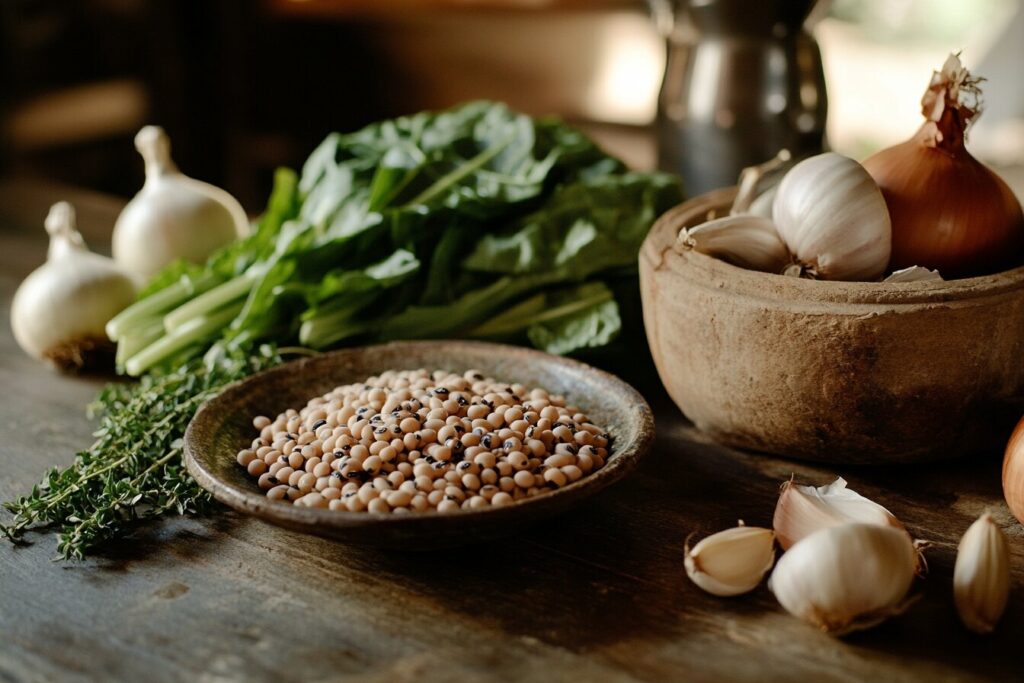
Essential Ingredients for Perfect Black Eyed Peas and Collard Greens
Making the perfect dish of dried black eyed peas and fresh collard greens needs the right mix of ingredients. Whether you like the classic Southern way or a new twist, knowing the key ingredients is key to great taste.
The dried black eyed peas are at the heart of this recipe. They have a nutty taste and a creamy feel. The fresh collard greens add a nice bitterness and a strong, earthy flavor.
Smoked turkey leg or wing adds a smoky, salty taste. Onions and garlic make the flavors even better, blending them in a way that excites your taste buds.
If you want something different, you can use smoked turkey, smoked beef sausage, or even vegetarian choices like mushrooms or vegetable broth. This lets everyone find something they like.
No matter what ingredients you pick, the secret to a great black eyed peas and collard greens dish is in how you prepare each one. It’s all about making a meal that’s both delicious and true to its roots.
Preparing and Soaking Black Eyed Peas
Getting dried black eyed peas ready is key to tender and tasty results. It might seem hard, but with a few tricks, you’ll get perfect beans every time.
Quick Soak Method
For a fast soak, put the peas in a big pot and cover them with at least 3 inches of water. Boil the water, then turn off the heat and soak for 1 hour. After draining, they’re ready for your recipe.
Overnight Soaking Tips
- Put the dried black eyed peas in a big bowl or pot and cover with at least 3 inches of water.
- Let them soak overnight, or for 8-12 hours.
- Drain and rinse the peas before using in your recipe.
Sorting and Cleaning Techniques
Before soaking, sort through the peas to remove stones, debris, or discolored ones. Spread them on a baking sheet and pick out unwanted items. Then, rinse them well under cold water to clean them.
| Soaking Method | Time Required | Benefits |
|---|---|---|
| Quick Soak | 1 hour | Faster preparation time |
| Overnight Soak | 8-12 hours | Softer, more tender beans |
By using these tips for soaking dried beans, quick soak method, and bean preparation, you’ll make the best black eyed peas and collard greens dish.
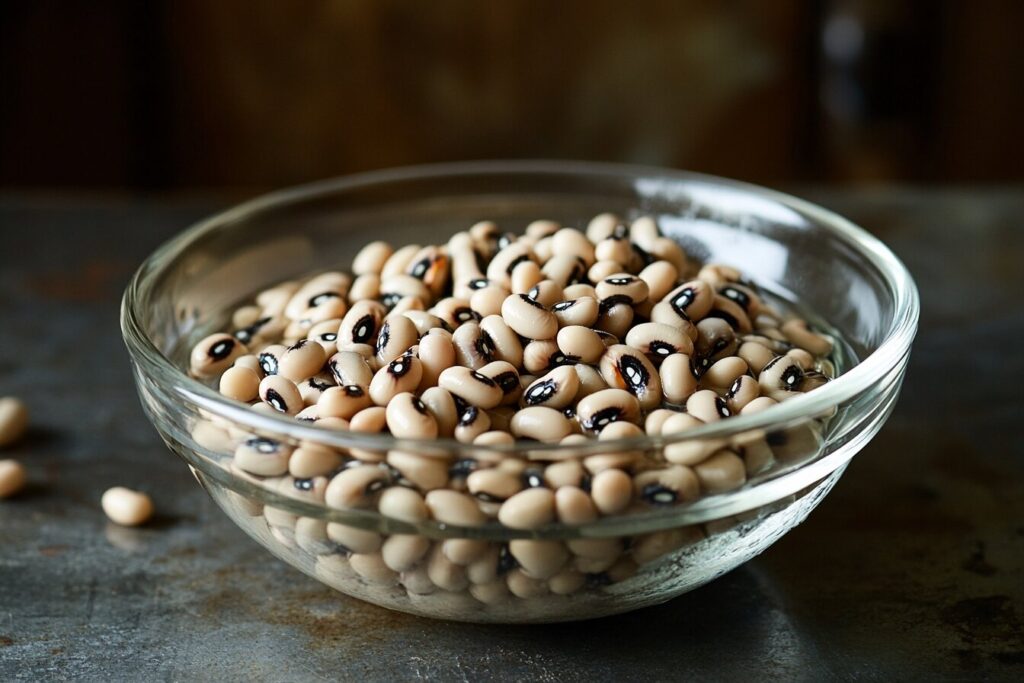
Selecting and Cleaning Fresh Collard Greens
Choosing the right fresh collard greens is key to a great black-eyed peas and collard greens dish. Fresh collards are the heart of this Southern American classic. Taking the time to pick the best leaves and clean them well can greatly improve the dish’s flavor and texture.
Start by picking fresh collards with bright green leaves and strong, healthy stems. Steer clear of wilted, yellow, or discolored leaves. When washing greens, make sure to get rid of dirt, debris, and tough stems that could ruin the dish.
- Put the collard greens in a big bowl of cool water. Gently move them around to loosen any dirt or grit.
- Take the greens out of the water and wash them again until the water is clear. This means they’re clean.
- Use a sharp knife or kitchen shears to remove the stems from the leaves. Be careful not to throw away any of the tasty green parts.
With these easy steps, you’ll have plenty of fresh, clean collard greens. They’re ready to be turned into a comforting and healthy part of your black-eyed peas feast. By focusing on quality ingredients and proper preparation, you’re on your way to making a dish that will please your taste buds and warm your heart.
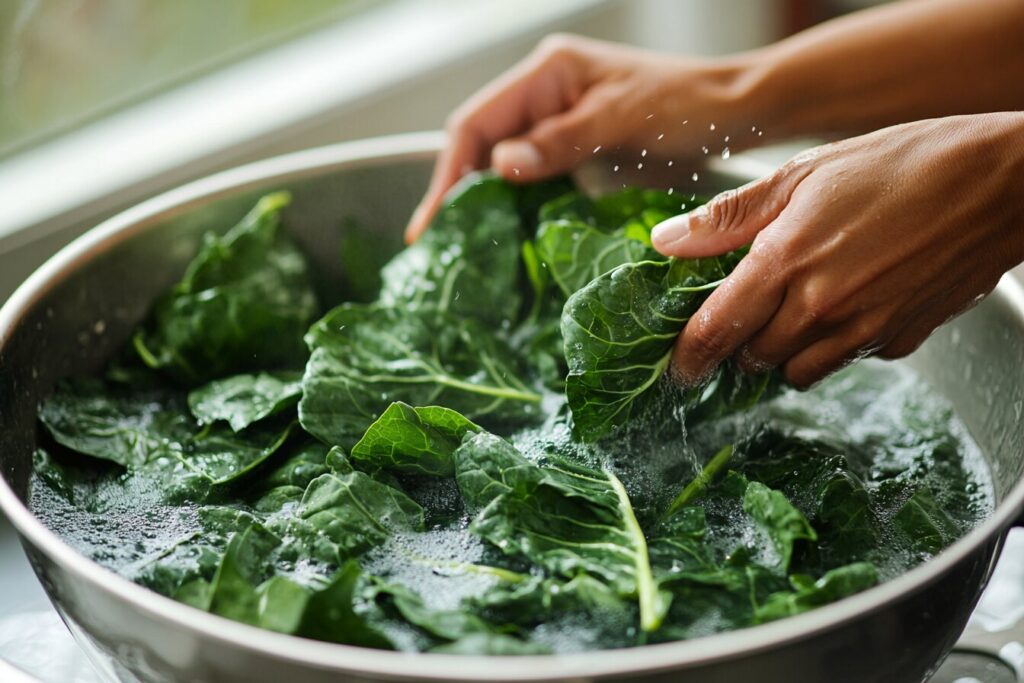
Seasoning and Flavor Enhancement Techniques
Perfecting the flavors of black eyed peas and collard greens starts with seasoning. You can use traditional Southern spices, meat, or vegetarian options. Each method can make the dish taste amazing.
Traditional Seasonings
The Southern way to season these dishes often includes garlic, onion, and bell peppers. Spices like smoked paprika, cayenne pepper, and thyme or oregano add depth. Smoked turkey or smoked beef sausage brings a smoky, savory flavor.
Meat-Based Flavoring Options
Meat lovers can enhance the dish with smoked turkey or smoked beef sausage. The fat from these meats adds a smoky taste. It also makes the vegetables tender and rich.
Vegetarian Alternatives
- Vegetable broth or stock can be a tasty substitute for meat broth.
- Spices like cumin, chili powder, and smoked paprika can mimic meat flavors.
- Mushrooms, like shiitake or portobello, add an earthy, umami taste to vegetarian versions.
Trying different seasoning techniques lets you customize the flavors of black eyed peas and collard greens. This way, you can make a dish that’s both satisfying and memorable.
Step-by-Step Cooking Instructions
Making a perfect one-pot meal with cooking black eyed peas and simmering collard greens is easy. It brings out the best in traditional Southern flavors. Just follow these simple steps to make a dish that’s both comforting and nutritious.
- Rinse the black eyed peas well and remove any debris or stones. Put them in a big pot and cover with 2 inches of water. Boil, then lower the heat and simmer for 10 minutes.
- Drain the black eyed peas and put them back in the pot. Add fresh water to cover them by 1 inch.
- Trim the tough stems from the collard greens and chop the leaves into 1-inch pieces. Add the collard greens to the pot with the black eyed peas.
- Add smoked turkey to the pot for a rich, smoky flavor. Stir well to mix all the flavors.
- Bring the pot to a boil, then reduce the heat to low. Cover and let it simmer for 45-60 minutes, stirring occasionally, until the peas and greens are tender.
For the best results, let the peas and greens simmer gently. Adjust the heat as needed to maintain a steady, gentle bubble. This slow cooking makes the ingredients tender and blends the flavors perfectly.
| Ingredient | Quantity |
|---|---|
| Black Eyed Peas | 1 pound |
| Collard Greens | 1 bunch, chopped |
| Onion, diced | 1 medium |
| Garlic, minced | 3 cloves |
| Smoked Paprika | 1 teaspoon |
| Cayenne Pepper | 1/4 teaspoon |
| Salt and Pepper | To taste |
By following these easy steps, you can create a delicious and comforting one-pot meal. It highlights the rich flavors of slow-cooked peas and simmered greens. Enjoy this classic Southern dish with your loved ones.
Serving Suggestions and Accompaniments
Adding the right sides to this classic peas and greens dish can elevate the meal. Traditional Southern side dishes like cornbread, rice, and fried okra are great choices. They complement the flavors and textures of this hearty meal.
Traditional Side Dishes
- Cornbread: A warm, crumbly slice of cornbread is essential for a Southern meal. It pairs well with the savory peas and greens.
- Rice: White or red rice pairs perfectly with this Southern peas and greens dish. It soaks up the flavorful pot likker.
- Fried Okra: The crispy, golden fried okra adds a satisfying crunch. It brings a taste of the South to this comforting dish.
- Macaroni and Cheese: A creamy, cheesy mac and cheese complements the earthiness of the greens. It also matches the heartiness of the black eyed peas.
Cornbread Pairings
The classic skillet-baked cornbread is iconic. For a true Southern comfort food experience, serve it with this hearty peas and greens dish. Drizzle with honey or dot with butter for extra flavor. Alternatively, crumble the cornbread into the mixture for a fun textural contrast.
| Side Dish | Flavor Profile | Serving Suggestion |
|---|---|---|
| Cornbread | Sweet, crumbly, and dense | Serve warm, with butter or honey |
| Rice | Mild, absorbent, and fluffy | Ladle black eyed peas and greens over rice |
| Fried Okra | Crispy, savory, and slightly tangy | Scatter fried okra over the top of the dish |
| Macaroni and Cheese | Creamy, cheesy, and comforting | Serve as a side, or mix into the peas and greens |
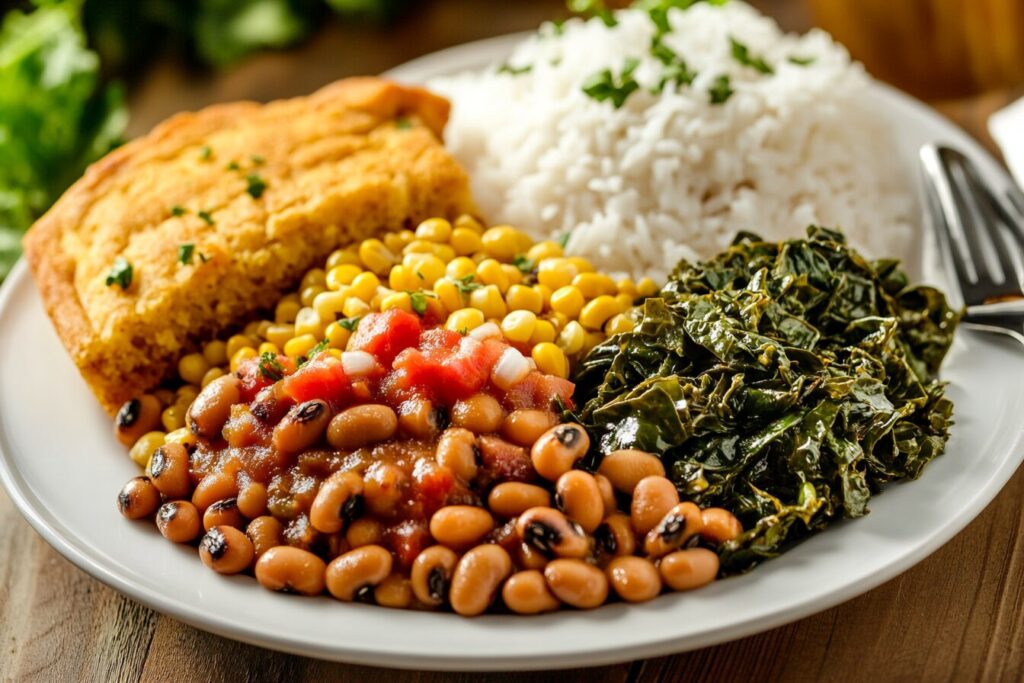
Storage and Reheating Guidelines
Enjoying these peas and greens doesn’t have to stop after dinner. You can keep these tasty dishes fresh for days with the right storage and reheating.
Storing Leftovers
Keep your leftovers fresh by putting them in airtight containers or plastic bags. Let the food cool down completely before storing it in the fridge. It will stay good for 3-4 days there.
Freezing for Longer Shelf Life
Freezing, therefore, is a great way to keep leftovers longer. To do this, just put the peas and greens in freezer-safe containers or bags. Additionally, make sure to leave some space for expansion. As a result, they can stay tasty for 3-4 months.
Reheating with Care
When reheating, be careful not to dry out the food. Here are some good ways to do it:
- Stovetop: Warm the peas and greens in a saucepan over medium heat, stirring now and then.
- Microwave: Put the leftovers in a microwave-safe dish, add a bit of water, and heat in 30-second bursts, stirring between each.
- Oven: Preheat to 350°F (175°C), then reheat in an oven-safe dish for 10-15 minutes.
By following these tips for storing, freezing, and reheating leftovers, you can enjoy your dish for an extended period.
Conclusion
The black eyed peas and collard greens dish is a beloved part of Southern cultural heritage and cuisine. Moreover, it’s a hearty, nutritious meal that feeds both the body and soul. In addition, it keeps alive the traditions passed down through generations.
Over the years, this dish has grown from a simple staple of Southern comfort food to a modern favorite. Not only does it bring families and communities together, but it also celebrates the flavors and values that are at the heart of the region.
Traditionally, black eyed peas and collard greens are enjoyed on New Year’s Day for good luck. However, they are also eaten throughout the year. They show the strength and flexibility of Southern culinary traditions. By learning to make this dish, home cooks can nourish themselves and their families. Furthermore, they honor the cultural legacy that makes it a favorite.
Finally, when you enjoy the earthy, robust flavors of this classic Southern dish, remember its rich history and significance. The black eyed peas and collard greens recipe is more than just a meal. Ultimately, it’s a connection to the roots and values of the South.
FAQ
What are the key ingredients in black eyed peas and collard greens?
This Southern dish needs dried black eyed peas, fresh collard greens, and smoked turkey leg or wing. Onions and garlic add flavor.
How do you prepare and soak the black eyed peas?
You can soak black eyed peas quickly or overnight. Sorting, cleaning, and soaking are key for even cooking and texture.
What are some tips for selecting and cleaning the collard greens?
Choose fresh, vibrant collard greens. Wash them well and remove tough stems or ribs for a tender dish.
How do you season and enhance the flavors of black eyed peas and collard greens?
Use smoked paprika, garlic, onions, and smoked turkey or smoked beef sausage for flavor. Mushrooms or vegetable broth add depth for vegetarians.
What are the step-by-step instructions for cooking black eyed peas and collard greens together?
Simmer soaked black eyed peas and cleaned collard greens together. This blends flavors and tenderizes the dish.
What classic side dishes pair well with black-eyed peas and collard greens?
Serve with cornbread, rice, and other leafy greens for a hearty meal. Cornbread is a classic choice.
What is the best way to store and reheat leftover black-eyed peas and collard greens?
Store leftovers in the fridge for 4-5 days. Freeze for longer storage. Reheat on the stovetop or microwave for best taste and texture.

